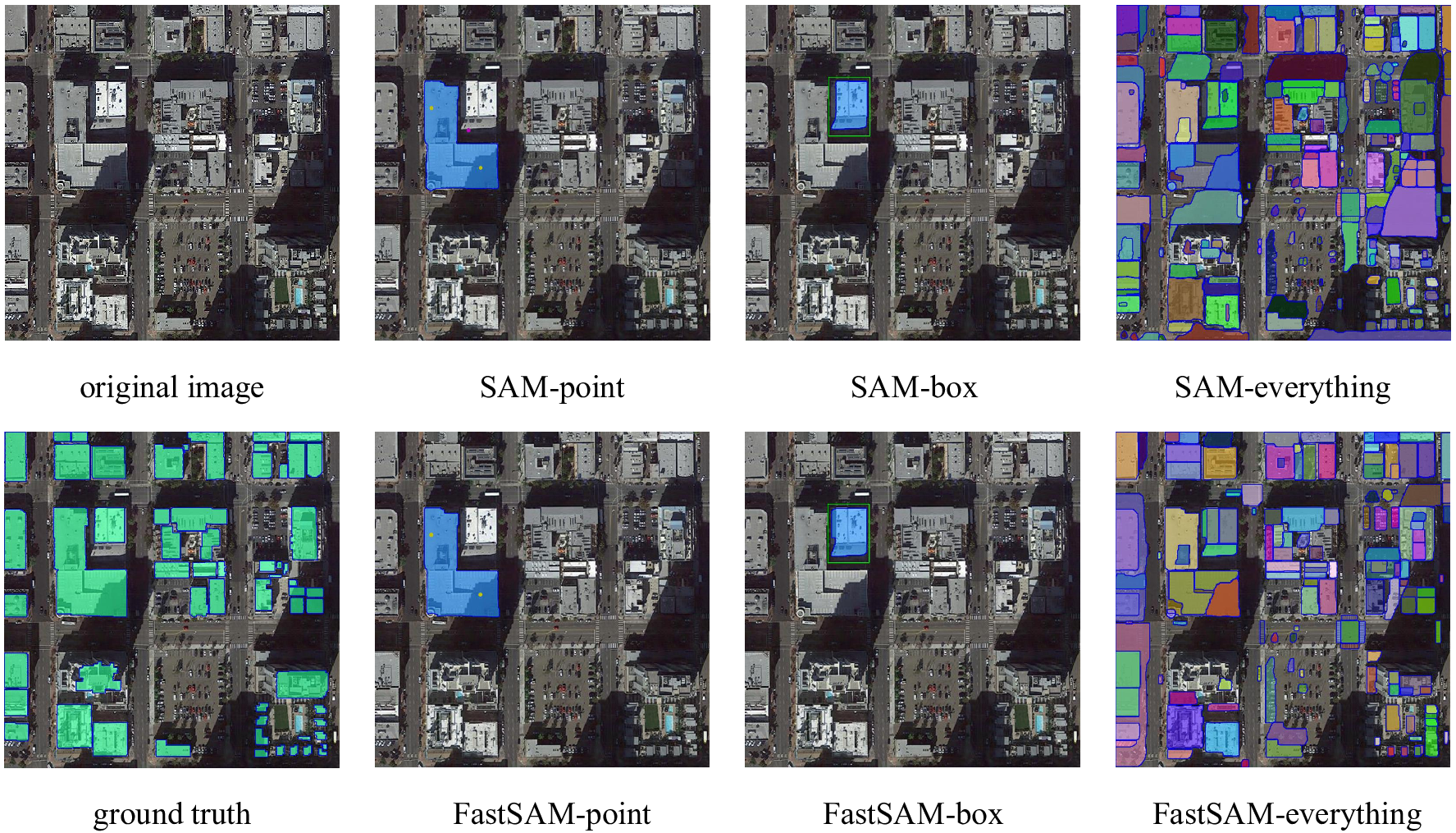[Paper] [Web Demo] [Colab demo] [Model Zoo] [BibTeX]
The Fast Segment Anything Model(FastSAM) is a CNN Segment Anything Model trained by only 2% of the SA-1B dataset published by SAM authors. The FastSAM achieve a comparable performance with the SAM method at 50× higher run-time speed.
Clone the repository locally:
git clone https://github.com/CASIA-IVA-Lab/FastSAM.git
Create the conda env. The code requires python>=3.7, as well as pytorch>=1.7 and torchvision>=0.8. Please follow the instructions here to install both PyTorch and TorchVision dependencies. Installing both PyTorch and TorchVision with CUDA support is strongly recommended.
conda create -n FastSAM python=3.9
conda activate FastSAM
Install the packages:
cd FastSAM
pip install -r requirements.txt
Install clip:
pip install git+https://github.com/openai/CLIP.git
First download a model checkpoint.
Then, you can run the scripts to try the everything mode and three prompt modes.
# Everything mode
python Inference.py --model_path ./weights/FastSAM.pt --img_path ./images/dogs.jpg
# text prompt
python Inference.py --model_path ./weights/FastSAM.pt --img_path ./images/dogs.jpg --text_prompt "the yellow dog"
# box prompt (xywh)
python Inference.py --model_path ./weights/FastSAM.pt --img_path ./images/dogs.jpg --box_prompt "[570,200,230,400]"
# points prompt
python Inference.py --model_path ./weights/FastSAM.pt --img_path ./images/dogs.jpg --point_prompt "[[520,360],[620,300]]" --point_label "[1,0]"
You are also welcomed to try our Colab demo: FastSAM_example.ipynb.
We provide various options for different purposes, details are in MORE_USAGES.md.
In the web demo, you can upload your own image, select input size from 512~1024, and choose whether to visualize in high quality. High quality visualization additionally shows more easily observable split edges. The web demo only supports Everything Mode now, other modes will try to support in the future.
Two model versions of the model are available with different sizes. Click the links below to download the checkpoint for the corresponding model type.
defaultorFastSAM: YOLOv8x based Segment Anything Model.FastSAM-s: YOLOv8s based Segment Anything Model.
All result were tested on a single NVIDIA GeForce RTX 3090.
Running Speed under Different Point Prompt Numbers(ms).
| method | params | 1 | 10 | 100 | E(16x16) | E(32x32*) | E(64x64) |
|---|---|---|---|---|---|---|---|
| SAM-H | 0.6G | 446 | 464 | 627 | 852 | 2099 | 6972 |
| SAM-B | 136M | 110 | 125 | 230 | 432 | 1383 | 5417 |
| FastSAM | 68M | 40 | 40 | 40 | 40 | 40 | 40 |
| Dataset | Method | GPU Memory (MB) |
|---|---|---|
| COCO 2017 | FastSAM | 2608 |
| COCO 2017 | SAM-H | 7060 |
| COCO 2017 | SAM-B | 4670 |
Test on the BSDB500 dataset.
| method | year | ODS | OIS | AP | R50 |
|---|---|---|---|---|---|
| HED | 2015 | .788 | .808 | .840 | .923 |
| SAM | 2023 | .768 | .786 | .794 | .928 |
| FastSAM | 2023 | .750 | .790 | .793 | .903 |
| method | AR10 | AR100 | AR1000 | AUC |
|---|---|---|---|---|
| SAM-H E64 | 15.5 | 45.6 | 67.7 | 32.1 |
| SAM-H E32 | 18.5 | 49.5 | 62.5 | 33.7 |
| SAM-B E32 | 11.4 | 39.6 | 59.1 | 27.3 |
| FastSAM | 15.7 | 47.3 | 63.7 | 32.2 |
bbox AR@1000
| method | all | small | med. | large |
|---|---|---|---|---|
| ViTDet-H | 65.0 | 53.2 | 83.3 | 91.2 |
| zero-shot transfer methods | ||||
| SAM-H E64 | 52.1 | 36.6 | 75.1 | 88.2 |
| SAM-H E32 | 50.3 | 33.1 | 76.2 | 89.8 |
| SAM-B E32 | 45.0 | 29.3 | 68.7 | 80.6 |
| FastSAM | 57.1 | 44.3 | 77.1 | 85.3 |
| method | AP | APS | APM | APL |
|---|---|---|---|---|
| ViTDet-H | .510 | .320 | .543 | .689 |
| SAM | .465 | .308 | .510 | .617 |
| FastSAM | .379 | .239 | .434 | .500 |
Several segmentation results:
The results of several downstream tasks to show the effectiveness.
The model is licensed under the Apache 2.0 license.
- Segment Anything provides the SA-1B dataset and the base codes.
- YOLOv8 provides codes and pre-trained models.
- YOLACT provides powerful instance segmentation method.
- Grounded-Segment-Anything provides a useful web demo template.
If you find this project useful for your research, please consider citing the following BibTeX entry.
@misc{zhao2023fast,
title={Fast Segment Anything},
author={Xu Zhao and Wenchao Ding and Yongqi An and Yinglong Du and Tao Yu and Min Li and Ming Tang and Jinqiao Wang},
year={2023},
eprint={2306.12156},
archivePrefix={arXiv},
primaryClass={cs.CV}
}








